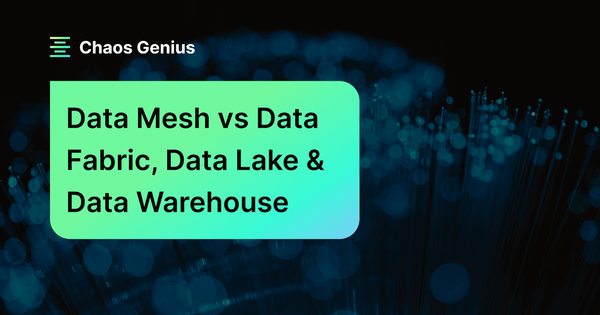Organizations today have a tough time handling their huge, complicated data ecosystems. The demand for data-driven decision-making is growing, so new concepts like Data Mesh, Data Fabric, Data Lakes, and Data Warehouses have emerged. Each has its pros and cons. Data Mesh and Data Fabric represent distinct data platform architectures; Data Mesh focuses on decentralizing data ownership, helping data teams manage their own data, while Data Fabric focuses on a unified architecture that integrates and governs data across the organization. Data Lakes and Data Warehouses, on the other hand, serve as storage solutions. Data Lakes is a centralized storage repository that allows for the storage of vast amounts of structured and unstructured data, whereas Data Warehouses store structured, processed data optimized for analytics.
In this article, we will cover everything you need to know about Data Lakes, Data Warehouses, Data Mesh and Data Fabric, providing a clear understanding of each concept and how they compare against one another.
The BIG Four—Understanding the Basic Concepts
Before delving into a detailed analysis, it is essential to understand what each of these concepts represents. Let's take a closer look at Data Mesh, Data Fabric, Data Lake, and Data Warehouse—focusing on their key features, strengths, use cases, and pros & cons.
1) What Is Data Mesh?
Data Mesh is a decentralized approach to data architecture that emphasizes domain-oriented ownership and self-serve data infrastructure. It aims to overcome the limitations of centralized data management by distributing data ownership across different business domains and treating data as a product, with dedicated teams responsible for data quality and usability.
Let's dive into the main traits of Data Mesh.
- Decentralized data ownership
- Domain-driven data products
- Distributed data governance
- Self-serve data infrastructure
- Interoperability through standardization
- Scalability through domain decomposition
- Improved data quality and accessibility
4 Core Principles of Data Mesh:

1) Domain-Oriented Decentralization: Each domain is responsible for its own data.
2) Data as a Product: Data is treated as a product, with dedicated teams ensuring quality and usability.
3) Self-Serve Data Infrastructure: Tools and platforms are provided for teams to manage their own data.
4) Federated Governance: Governance policies are flexible and domain-specific.
Data Warehouse Architecture Overview
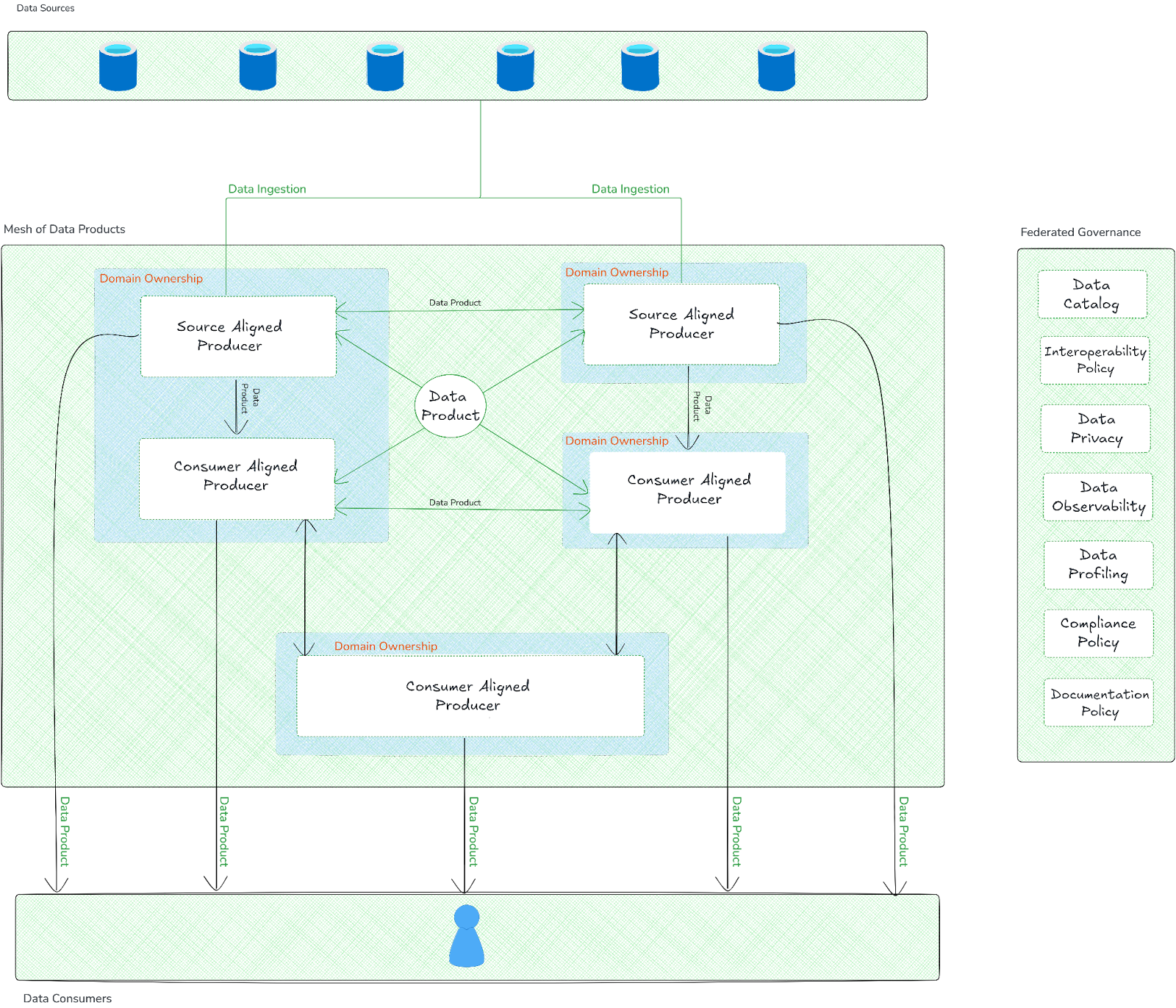
Pros and Cons of Data Mesh
Pros:
- Data Mesh allows individual teams to own their data products, increasing accountability and relevance.
- Data Mesh reduces bottlenecks by enabling teams to manage their own data, leading to faster access and processing.
- Data Mesh's data-as-a-product approach encourages sharing data across teams, which helps break down barriers and improve collaboration.
- Data Mesh scales easily with the organization, adapting to changing needs and technologies.
- With Data Mesh, teams own their data, so they have to make sure it's correct and reliable since they understand their data better.
- Data Mesh supports federated governance, balancing flexibility with compliance and security.
Cons:
- Transitioning to Data Mesh can be costly due to restructuring, training, and new technologies.
- Switching to Data Mesh can be pricey and requires a cultural shift in how people think and work, which might get pushback from the people involved.
- The decentralized model in Data Mesh can create confusion about data ownership and responsibilities, affecting data quality.
- Implementing Data Mesh needs careful planning and alignment across different domain teams, which can be complex.
- There are currently no all-in-one vendor solutions for Data Mesh, requiring various tools to be integrated.
- Multiple teams managing their own data can lead to inconsistencies in governance and standards.
Save up to 30% on your Snowflake spend in a few minutes!


2) What is a Data Fabric?
Data Fabric is an architectural framework that facilitates seamless integration, management, and governance of data across various environments, including on-premises and cloud platforms. It is designed to help organizations manage their data more effectively, guaranteeing consistent access, integration, and security across heterogeneous environments.
Data Fabric has some important traits. Here's what they are:
- Seamless data integration across diverse environments
- Centralized metadata management
- Automated data discovery and cataloging
- Consistent data governance and security
- Real-time data processing capabilities
- Support for hybrid and multi-cloud environments
- AI-driven data management and optimization
Data Fabric Architecture Overview
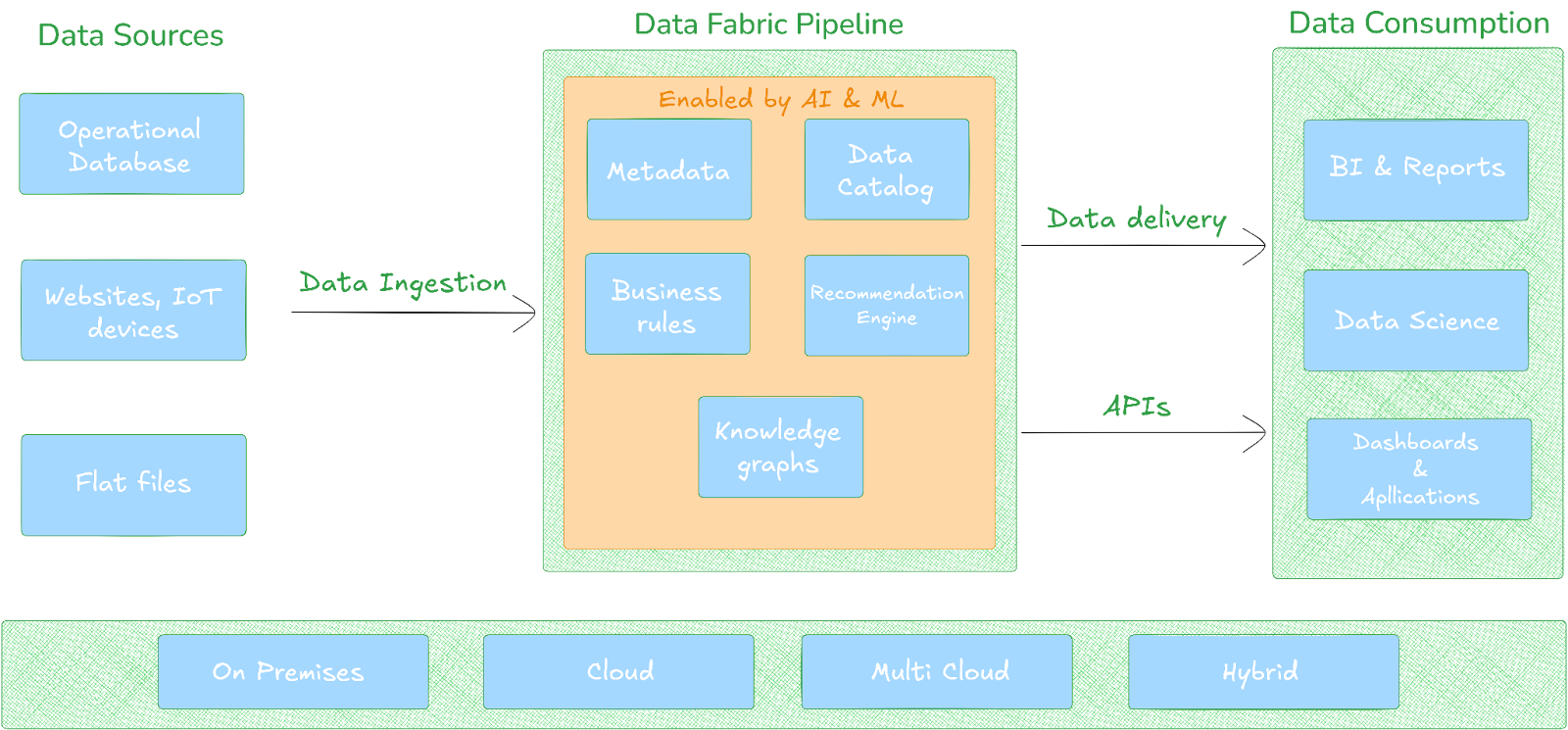
Pros and Cons of Data Fabric
Pros:
- Data Fabric provides a unified platform for connecting various data sources, simplifying data management.
- Centralized data management in Data Fabric allows organizations to enforce consistent security and compliance measures.
- Data Fabric enables efficient data management by aggregating information from previous queries, dramatically reducing query response times.
- Data Fabric provides broad access to and use of data within the same organization, enabling useful predictions and improved system performance.
- Data Fabric encourages the reuse of data assets, minimizing unnecessary duplication and optimizing storage.
- Data Fabric enables AI and ML driven enforcement of data governance policies, improving data security while providing broad data access.
- Data Fabric continuously improves data quality by integrating AI and ML capabilities.
Cons:
- Data Fabric is biased in favor of centralized, as against decentralized, access, which can be a drawback for some organizations.
- Data Fabric is frequently positioned as a disruptive, zero-sum architecture, which may not be the case, as it is more helpful to conceive of it as a complement to, not a replacement for, data management tools, practices, and concepts.
- The centralized nature of the Data Fabric may lead to potential bottlenecks, slower responsiveness to domain-specific needs, dependency on a centralized team, and scalability challenges.
- Centralized data management in Data Fabric may restrict innovation and experimentation, as teams may not have the autonomy to explore new technologies and approaches best suited to their domain requirements.
- Many tools necessary for Augmented Metadata and active metadata collection in Data Fabric are still new.
3) What is a Data Lake?
Data Lake is a centralized repository that stores a significant volume of data in its original, unprocessed state. Compared to a traditional Data Warehouse, which stores data in files or folders, a Data Lake uses a flat design and object storage to store data. Data Lakes enables numerous applications to access data by utilizing low-cost object storage and open formats.
In a Data Lake, raw data from varied sources like databases, applications, and the web is collected and made available for analysis. This avoids costly ETL jobs to curate and structure the data upfront. So, here is what makes Data Lakes special:
- Store all types of data (structured, semi-structured, unstructured)
- Schema-on-read approach
- Highly scalable and flexible
- Cost-effective for large volumes of data
- Supports advanced analytics and machine learning, streaming, or data science
- Requires data governance to prevent becoming a "data swamp"
Data Lake Architecture Overview
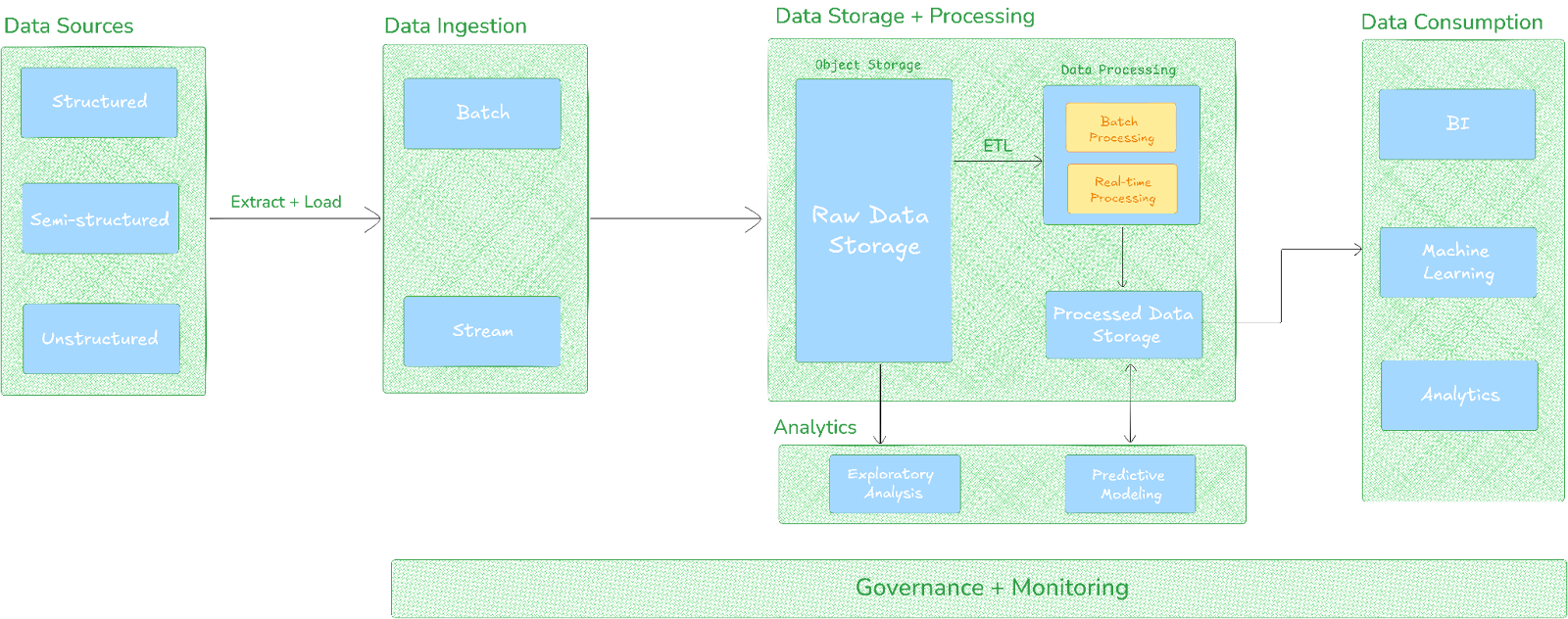
Pros and Cons of Data Lake
Pros:
- Data Lakes provide a cost-effective way to store heaps of different data types, from structured to unstructured.
- Data Lakes can handle a wide range of data formats, so you can store data from all sorts of sources.
- Data Lakes lets you dive into raw data without needing to prep it first, making it perfect for exploratory analysis.
- Data Lakes help minimize duplication by storing all raw data in one place.
- A shared data storage platform helps data scientists and analysts work together better.
Cons:
- If you don't have the right governance, the raw data in your Data Lake can be a mess, leading to insights you can't trust.
- As your Data Lake grows, managing all that data can get super complicated.
- If you don't have proper management, your Data Lake can turn into a data swamp, making it hard to find what you need.
- Data Lakes aren't always the best choice for certain queries, so you might see slow performance.
- Some Data Lake solutions can tie you to a specific cloud vendor, making it tough to switch later on.
4) What is a Data Warehouse?
Data Warehouse is a centralized repository designed specifically for query and analysis rather than transaction processing. It integrates structured data from various sources, providing a "single source of truth" for business intelligence and reporting. Modern Data Warehouses often utilize cloud-based architectures, offering greater flexibility and scalability. Here are some key characteristics of Data Warehouses:
- Store structured, processed data
- Schema-on-write approach
- Optimized for read operations and complex queries
- Designed for data analysis and reporting
- Ensures data consistency and quality
- Typically more expensive for large data volumes
- Limited flexibility for unstructured data
Data Warehouse Architecture Overview

Pros and Cons of Data Warehouse
Pros:
- Data Warehouses are optimized for fast querying, making them ideal for analytical workloads.
- Data Warehouses can store data in a structured format, so it's easy to find and analyze what you need.
- Data Warehouses enforce strict quality standards, so you can trust the data is accurate and reliable.
- There are different tools and technologies available to help you build and maintain your Data Warehouse.
- Plus, Data Warehouse has robust governance mechanisms in place to keep your data safe and compliant.
Cons:
- Setting up and running a Data Warehouse can be expensive due to hardware, software, and resource needs.
- Data Warehouses are meant for neat and tidy structured data, so they're not great with messy unstructured data types.
- Traditional old-school implementations can create data silos, making it a hassle to share data between teams.
- Building a Data Warehouse takes time, which means you won't see the benefits of analyzing your data right away.
- Some Data Warehouses can process data pretty quickly, but they might not cut it for apps that need super-speedy real-time analytics.
What Is the Difference Between a Data Warehouse and a Data Lake?
Now, you know the basics of Data Lake vs Data Warehouse—their pros and cons too. Okay, next, let's see how they differ from each other.
| Data Lake | Data Warehouse |
| Data Lake is a storage repository that holds a vast amount of raw data in its native format until needed. | Data Warehouse is a centralized repository for structured data, designed for business intelligence and analysis. |
| Data Lake can store structured, semi-structured, and unstructured data. | Data Warehouse stores structured data only, with predefined schemas. |
| Data Lake uses a schema-on-read approach, where data is stored in its raw format and schemas are applied when the data is accessed. | Data Warehouse uses a schema-on-write approach, where data is cleaned, transformed, and structured before being stored. |
| Data Lake typically follows an ELT (Extract, Load, Transform) process, loading raw data first and transforming it when necessary. | Data Warehouse typically follows an ETL (Extract, Transform, Load) process, where data is transformed and cleaned before loading into the warehouse. |
| Data Lake is primarily used by data scientists, engineers, and analysts for advanced analytics, machine learning, and big data exploration. | Data Warehouse is used by business intelligence professionals and analysts for reporting, data analysis, and decision-making processes requiring structured data. |
| Data Lake is highly scalable and cost-effective for storing large volumes of diverse data types, but may incur higher processing costs. | Data Warehouse offers fast query performance and optimized data access, but can be more expensive due to complex infrastructure and maintenance needs. |
| Data Lake allows for the storage and integration of raw data, supporting diverse data types, but may have more complex security requirements. | Data Warehouse integrates and processes data before storage, ensuring high data quality and robust security through centralized storage and strict access controls. |
| Storage costs are fairly inexpensive in a Data Lake vs a Data Warehouse. Data lakes are also less time-consuming to manage, which reduces operational costs. | Data warehouses cost more than Data Lakes, and also require more time to manage, resulting in additional operational costs. |
Data Mesh vs Data Fabric, Lake & Warehouse—Comparative Analysis
Before we go into the specifics of each data architecture and data storage solutions, let's see how these data paradigms compare in terms of scalability, flexibility, and governance.
What Is the Difference Between Data Mesh and Data Fabric?
These two architectures may appear similar at first glance, but their approaches to data management could not be more different—let's look at the fundamental differences between Data Mesh vs Data Fabric.
Data Mesh vs Data Fabric:
| Data Fabric | Data Mesh |
| Data Fabric is a metadata-driven approach for connecting disparate data tools in a cohesive, self-service manner | Data Mesh is a decentralized approach encouraging distributed teams to manage data as they see fit with some common governance |
| Data Fabric is technology-centric, focusing on creating a unified management layer over distributed data sources without centralizing storage | Data Mesh focuses on organizational change, emphasizing domain-oriented data ownership with decentralized storage and management by domain-specific teams |
| It delivers capabilities like data access, discovery, transformation, integration, security, governance, lineage, and orchestration, often using APIs and common JSON data format for integration | It promotes domain-oriented architecture with characteristics such as data as a product, self-serve data infrastructure, and federated computational governance, with more hands-on coding required for API integration |
| The management in Data Fabric is unified, providing centralized governance and security across various data sources | Data Mesh advocates for federated governance, allowing domain-specific teams to have autonomy while adhering to some central guidelines |
| Data Fabric simplifies data access and management in a heterogeneous environment, integrating various components typically via low-code or no-code API solutions | Data Mesh allows teams to build and manage their own systems based on specific needs, encouraging innovation and flexibility through a bottom-up management style |
| Tools and vendors supporting Data Fabric include Informatica, Talend, Ataccama, Denodo, and Google Cloud (Dataplex), offering integrated solutions for data management | Data Mesh is a conceptual framework not tied to specific tools, driven more by organizational practices and how teams manage and govern data |
| Data Fabric is generally used by data stewards, data engineers, data analysts, and data scientists to manage data across repositories and platforms | Data Mesh empowers individual teams, including developers and domain-specific groups, to manage and own their data, treating it as a product |
| Data Fabric emerged to simplify the management of data in increasingly complex environments, handling diverse data sources and platforms | Data Mesh emerged to address the usability gap between Data Warehouses and Data Lakes, enhancing real-time data flows and promoting decentralized ownership |
| Data Fabric handles the complexity of data and metadata through a unified, cohesive management approach, which works well with existing data architectures | Data Mesh rectifies the incongruence between Data Lakes and Data Warehouses by reimagining data ownership structures in a decentralized, domain-oriented manner |
What Is the Difference Between Data Mesh and Data Lake?
Data Lakes and Data Meshes are two different ways to handle data. They're like opposites.
So what exactly are Data Mesh vs Data Fabric?
Zhamak Dehghani introduced Data Mesh to overcome the limitations of traditional data architectures, which often struggle to scale and adapt to the complex needs of modern businesses. A Data mesh is a decentralized sociotechnical approach to sharing, accessing, and managing analytical data in complex, large-scale environments—within or across organizations. A Data Lake, on the other hand, is a place to store lots of raw data that can be processed later. It is highly scalable and cost-effective for storing large volumes of diverse data types. While a Data Mesh may utilize a Data Lake as its central data store, it is not solely a data architecture model—it controls how data is managed.
A Data Mesh differs from traditional data infrastructures that centralize storage and processing in a Data Lake. Instead, it promotes distributed data management. Domain-specific teams manage their own data products and pipelines based on their needs, while a universal interoperability layer ensures consistent syntax and data standards across the organization.
Here are some key differences between Data Mesh vs Data Lake
- Data mesh supports self-service data usage; a Data Lake does not.
- Data meshes need stricter rules and standards about how data is formatted and described.
- In a Data Lake architecture, the data team controls and owns all pipelines. In a Data Mesh architecture, domain owners manage their own pipelines.
Let's look at the differences between Data Mesh vs Data Lake more closely.
Data Mesh vs Data Lake:
| Data Mesh | Data Lake |
| Data Mesh is a decentralized approach to data architecture that emphasizes domain-oriented ownership and self-serve data infrastructure, enabling individual domains to manage and govern their data independently | Data Lake is a centralized repository that stores vast amounts of structured and unstructured data in its original, raw form, typically managed by a central IT team |
| Data Mesh promotes flexibility and scalability by allowing each domain to scale its data infrastructure and pipelines independently based on its specific needs | Data Lake scales vertically, which can become complex as it requires expanding the centralized infrastructure, often leading to significant operational overhead |
| Data Mesh enables domain-specific data governance, where each domain is responsible for data quality, compliance, and security within its scope | Data Lake relies on centralized data governance policies, which can be rigid and may not cater to the nuanced requirements of different business domains |
| Data Mesh uses a universal interoperability layer to maintain consistency across domains, ensuring that data from various sources adheres to the same standards and formats | Data Lake integrates data through centralized ETL (Extract, Transform, Load) processes, which can be complex and time-consuming, especially with diverse data sources |
| Data Mesh supports self-service data consumption, allowing domain teams to access and utilize data as needed without relying on a central team | Data Lake typically does not support self-service capabilities as seamlessly, often requiring intervention from central IT or data teams to manage and access data |
| Data Mesh requires strong alignment on data standards such as formatting, metadata fields, and governance, ensuring data discoverability and consistency across domains | Data Lake applies centralized data standards uniformly, which can sometimes lead to rigid data structures that are not easily adaptable to specific use cases |
| Data Mesh fosters a distributed, domain-oriented approach to data cataloging, where each domain manages its metadata and ensures the discoverability of its data products | Data Lake relies on a centralized data catalog to manage and navigate the vast amounts of data stored within the lake, which can become difficult to maintain as the data grows |
| Data Mesh typically involves diverse tooling across domains, allowing each domain to use the best tools for their specific needs | Data Lake often relies on a standardized set of tools optimized for large-scale, centralized data processing, which may not be flexible enough for all use cases |
| Data Mesh incurs costs that are distributed across domains, allowing for more optimized resource usage and budgeting based on specific domain requirements | Data Lake involves a centralized cost structure, with significant upfront investments in infrastructure that can be costly to maintain and scale over time |
| Data Mesh implements granular access controls at the domain level, which can be finely tuned to align with specific business rules and security requirements | Data Lake often has more rigid and centralized access controls, which can make it challenging to implement domain-specific security policies |
What Is the Difference Between Data Warehouse and Data Mesh?
Data warehouse is a centralized repository designed to store and manage large volumes of structured data. Traditionally, Data Warehouses were on-premises databases where an organization's data was integrated into a single source of truth. This approach aimed to create a comprehensive view by linking related data elements that reflect real-world operations. Data is extracted, transformed, and loaded (ETL) into the Data Warehouse, where it is organized into data marts for specific use cases, such as marketing or sales analytics.
BUT, the modern concept of a Data Warehouse has evolved significantly. Today, it often refers to cloud-based analytical databases like Snowflake, Redshift, and BigQuery. These platforms feature architectures that separate compute and storage, offering greater flexibility and scalability for handling massive amounts of data.
Data Mesh, on the other hand, is a decentralized data architecture that promotes domain-oriented ownership and self-serve data infrastructure. Compared to the centralized approach of traditional Data Warehouses—where a central team manages all data—a Data Mesh empowers individual domains (e.g., marketing, finance, product teams) to own and manage their data pipelines. These domains are connected through a universal interoperability layer that standardizes data governance and ensures consistency across the organization.
But the main question is do Data Warehouses and Data Meshes Work Together? The answer is: Yes, they can. A Data Mesh might use one or more Data Warehouses as part of its system. But they have different goals and ways of working.
Here are a few key differences between Data Mesh vs Data Warehouse.
1) Central vs Spread Out:
- Data Warehouse: One big, central system
- Data Mesh: Spread out across different teams
2) Who's in Charge:
- Data Warehouse: Usually managed by one central team
- Data Mesh: Each team manages their own data
3) Main Goal:
- Data Warehouse: Create one "source of truth" for all company data
- Data Mesh: Make it easier for teams to use data quickly
4) Flexibility:
- Data Warehouse: Can be slower to change
- Data Mesh: More flexible, easier to adapt quickly
5) Saving Space vs Saving Time:
- Data warehouses: Tries not to repeat data, which saves space.
- Data Mesh: May have some duplicate data to make things faster and easier for teams. Data meshes work well now because storing data is cheaper than it used to be.
Let's look at the differences between Data Mesh vs Data Warehouse more closely.
Data Mesh vs Data Warehouse:
| Data Mesh | Data Warehouse |
| Data Mesh is decentralized—data is owned and managed by domain-specific teams. Data is distributed across various platforms, with each domain responsible for its data products | Data Warehouse is centralized—data is collected, transformed, and stored in a single repository, often using a schema-on-write approach, providing a unified view of organizational data |
| Data Mesh empowers domain teams to handle their data, allowing them to build and manage pipelines that suit their specific needs, leading to faster and more domain-tailored data solutions | Data Warehouse relies on a centralized data team to manage and control data pipelines, ensuring consistent and unified data processing and management across the organization |
| Data Mesh supports scalability by distributing data management across multiple domains and platforms, enabling organizations to scale out their data operations with minimal bottlenecks | Data Warehouse faces scalability challenges, especially as data volumes grow, often requiring significant hardware investments and complex ETL processes to maintain performance |
| Data Mesh offers high flexibility and adaptability, enabling rapid integration of new data sources and changes in data requirements without affecting the entire system | Data Warehouse is less flexible, with changes in data sources or schema often requiring extensive ETL process updates and reconfigurations |
| Data Mesh fosters cross-functional collaboration between domain teams, data engineers, and business units, promoting a culture of shared responsibility for data quality and usability | Data Warehouse typically involves less cross-functional collaboration, with a dedicated data team responsible for managing data quality, governance, and access controls |
| Data Mesh uses modern technologies like cloud platforms, microservices, and containerization to create a flexible, scalable infrastructure that can evolve with organizational needs | Data Warehouse is often built using traditional database technologies and specialized warehousing solutions that may be less adaptable to rapid changes in technology or business requirements |
| Data Mesh places a strong emphasis on data quality within each domain, allowing for tailored data governance and quality standards that align with specific business needs | Data Warehouse centralizes data quality management, which can lead to slower quality improvements and a lack of domain-specific insights |
| Data Mesh is ideal for organizations with complex, diverse data needs that require scalable, flexible, and domain-oriented data management solutions | Data Warehouse is best suited for organizations that prioritize a unified, centralized approach to data management, offering consistent and reliable data for business intelligence and analytics |
Want to Learn More?
For further reading, consider exploring the following resources:
- Data Mesh Architecture 101—Guide to Its 4 Core Principles
- Data Mesh Wiki
- Databricks Delta Lake 101: A Comprehensive Primer
- What is a Data Warehouse?
- What is a Data Fabric?
- O'Reilly's Data Mesh Book
- Data Warehouse Toolkit
- Introduction to Data Mesh with Zhamak Dehghani
- What is a Data Lake?
- Data Fabric Explained
- Data Mesh vs Data Fabric vs Data Lake
- Exposing The Data Mesh Blind Side
- How Data Fabric Can Optimize Data Delivery
- Data Fabric vs Data Mesh
- Data Fabric vs Data Mesh: Everything You Need to Know

Want to take Chaos Genius for a spin?
It takes less than 5 minutes.
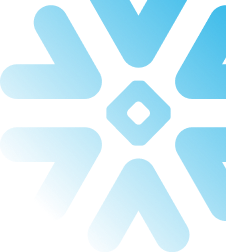
Conclusion
And that’s a wrap! Choosing between Data Mesh, Data Fabric, Data Lakes, and Data Warehouses really depends on what your organization needs, what you already have in place, and where you want to go with your data in the long run. Each option has its pros and cons, and knowing these can help you make smart decisions about your data setup.
In this article, we have covered:
- What is a Data Lake?
- Pros and Cons of Data Lake
- What is a Data Warehouse?
- Pros and Cons of Data Warehouse
- What Is Data Mesh?
- Pros and Cons of Data Mesh
- What is a Data Fabric?
- Pros and Cons of Data Fabric
- Difference Between:
- Data Mesh vs Data Fabric
- Data Mesh vs Data Lake
- Data Mesh vs Data Warehouse
…and so much more!
FAQs
What is a Data Mesh?
Data Mesh is a decentralized data architecture that emphasizes domain-oriented ownership and self-serve data infrastructure, distributing data management across different business domains.
What are the 4 pillars of Data Mesh?
The four core pillars are: Domain-Oriented Decentralization, Data as a Product, Self-Serve Data Infrastructure, and Federated Governance.
What is a Data Lake?
Data Lake is a centralized repository that stores vast amounts of raw data in its original format until needed, supporting various data types (structured, semi-structured, and unstructured).
What is the main advantage of a Data Lake?
Main advantage of a Data Lake is its ability to store vast amounts of data in various formats without the need for prior structuring, enabling flexible analytics.
How does Data Mesh improve data quality?
Data Mesh improves data quality by decentralizing data ownership, encouraging accountability, and allowing domain teams to manage their own data.
What are the challenges of implementing Data Fabric?
Challenges of implementing Data Fabric include potential high costs, complexity in architecture, and the risk of vendor lock-in.
Can a Data Lake and a Data Warehouse coexist?
Yes, a Data Lake and a Data Warehouse can coexist, with the Data Lake serving as a repository for raw data and the Data Warehouse providing structured data for analysis.
What is the role of governance in Data Fabric?
Governance in Data Fabric ensures data security, compliance, and quality across all integrated data sources, facilitating better decision-making.
What is the schema-on-read approach in Data Lakes?
Schema-on-read means that data is stored in its raw format, and schemas are applied only when the data is accessed or analyzed.
What is the primary use case for a Data Warehouse?
Data Warehouses are primarily used for business intelligence, reporting, and structured data analysis to support decision-making processes.
Is Data Fabric the same as Data Mesh?
No, Data Fabric and Data Mesh are distinct concepts. Data fabric is a technology-centric approach for unified data management, while Data Mesh is an organizational approach emphasizing decentralized, domain-oriented data ownership.
What is Data Mesh vs Data Fabric?
Data mesh is a decentralized, domain-oriented approach to data management, while Data Fabric is a centralized, technology-driven approach for integrating and managing data across diverse environments.
What is a Data Mesh vs Data Lake?
A Data Mesh is a decentralized data architecture emphasizing domain ownership, while a Data Lake is a centralized repository for storing large volumes of raw data in its native format.
Is mesh better than fabric?
Neither is inherently better; the choice depends on organizational needs.
How is Data Mesh different from Data Warehouse?
Data mesh is decentralized with domain-specific data ownership, while a Data Warehouse is centralized, storing structured data for specific analytical queries.
What is the difference between Data Warehouse vs Data Lake?
Data warehouse stores structured, processed data optimized for specific queries, while a Data Lake stores raw, unprocessed data in its native format, supporting various data types and more flexible analysis.

































